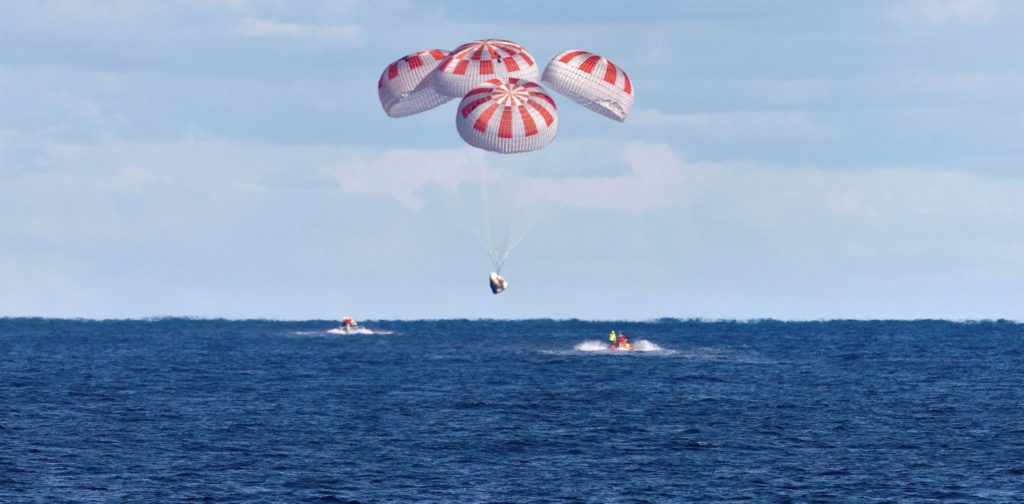On September 17th, a NASA blog post praised the progress SpaceX has made with Crew Dragon’s parachute system, indicating that the company is actually pushing the state of the art forward with improved modeling after dozens of tests.
Both before and after SpaceX completed Crew Dragon’s flawless March 2019 orbital launch debut, both NASA and the agency’s Aerospace Safety Advisory Panel (ASAP) have relentlessly focused on two main concerns: Falcon 9’s COPVs and Crew Dragon’s parachutes. The reasoning behind that focus is logical but may pose some problems.
Assuming that discussion points raised during quarterly ASAP and NASA Advisory Council (NAC) meetings are an accurate external representation of NASA’s internal Commercial Crew Program (CCP) priorities, the space agency has been focused on parachutes and COPVs for years. This is primarily a result of NASA’s notoriously reactive approach to safety: SpaceX suffered two COPV-related Falcon 9 failures in 2015 and 2016 and has experienced an unknown number (likely 1-3) of anomalies during Crew Dragon parachute testing.
As a result, NASA has focused extensively on these two stand-out concerns. To an extent, this is reasonable – if you know things have a tendency to fail, you’re going to want to make sure that they don’t. However, prioritizing reactive safety measures at the cost of proactive safety would be a major risk, akin to getting in a car crash because you didn’t use a turn signal and then prioritizing turn signal use so much that you forget to look both ways before making turns. Sure, you will probably never get in the same crash, but you are raising the risk of new kinds of accidents if you overcorrect your attention distribution.
NASA infamously suffered from this throughout the Space Shuttle program, analyzing known-quantities into oblivion as systematic organizational failures and glaring (but new) design flaws were either ignored or buried until it was far too late. It’s impossible to say if NASA is repeating this apparently deep-seated organizational error with Commercial Crew – only the technical experts at SpaceX and NASA have the data to accurately judge. It can be said with certainty, however, that the space agency (and its advisory panels) completely failed to predict the failure mode(s) that caused an April 20th Crew Dragon explosion that would have almost certainly killed all aboard, all while COPVs and parachutes continue(d) to be the apparent focus.
Pushing the envelope of parachute design
Qualms aside, NASA’s September 17th blog does serve as a unique look into the benefits that the space agency’s prioritization of the obvious – for better or for worse – is producing. According to NASA, the incredibly extensive testing SpaceX has had to do to satisfy agency requirements has lead the company to develop “a better understanding of how to safely design and operate parachute clusters”. SpaceX has reportedly completed 48 distinct parachute tests, of which one or two apparently failed.

In response to the additional testing and analysis NASA required after a recent April 2019 test failure, SpaceX has essentially been forced to push the state of the art of parachute design and modeling to new levels. NASA says that SpaceX has begun to model certain conditions and newfound failure modes in ways that “provide a better understanding of parachute reliability” and have forced NASA to reevaluate its own standards and certification processes. Shown in the video above, SpaceX recently completed a successful second attempt of its failed April 2019 parachute test, a major step towards confirming that the new parachute analysis and design have mitigated prior faults.
Check out Teslarati’s newsletters for prompt updates, on-the-ground perspectives, and unique glimpses of SpaceX’s rocket launch and recovery processes.

(adsbygoogle = window.adsbygoogle || []).push({});
<!–
–>
var disqus_shortname = «teslarati»;
var disqus_title = «SpaceX’s Crew Dragon is pushing the envelope of parachute engineering, says NASA»;
var disqus_url = «https://www.teslarati.com/spacex-nasa-crew-dragon-parachute-testing-progress/»;
var disqus_identifier = «teslarati-115406»;

